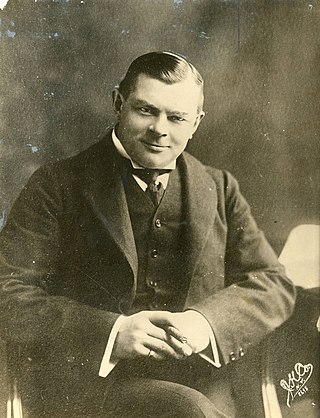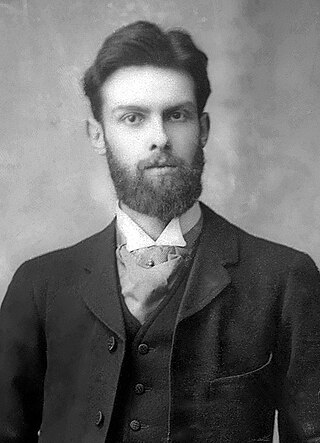
Charles Urban was a German-American film producer and distributor, and one of the most significant figures in British cinema before the First World War. He was a pioneer of the documentary, educational, propaganda and scientific film, as well as being the producer of the world's first successful motion picture colour system.

Kinemacolor was the first successful colour motion picture process. Used commercially from 1909 to 1915, it was invented by George Albert Smith in 1906. It was a two-colour additive colour process, photographing a black-and-white film behind alternating red/orange and blue/green filters and projecting them through red and green filters. It was demonstrated several times in 1908 and first shown to the public in 1909. From 1909 on, the process was known and trademarked as Kinemacolor and was marketed by Charles Urban’s Natural Color Kinematograph Company, which sold Kinemacolor licences around the world.

George Albert Smith was an English stage hypnotist, psychic, magic lantern lecturer, Fellow of the Royal Astronomical Society, inventor and a key member of the loose association of early film pioneers dubbed the Brighton School by French film historian Georges Sadoul. He is best known for his controversial work with Edmund Gurney at the Society for Psychical Research, his short films from 1897 to 1903, which pioneered film editing and close-ups, and his development of the first successful colour film process, Kinemacolor.

With Our King and Queen Through India (1912) is a British documentary film. The film is silent and made in the Kinemacolor additive color process.
Weston's Music Hall was a music hall and theatre that opened on 16 November 1857 at 242-245 High Holborn in London, England. In 1906, the theatre became known as the Holborn Empire.
The World, the Flesh and the Devil is a 1914 British silent drama film. Now considered a lost film, it was made using the additive color Kinemacolor process.
Wild Boy is a 1934 British comedy sports film directed by Albert de Courville and starring Sonnie Hale, Bud Flanagan and Chesney Allen. It was by Gainsborough Pictures at Lime Grove Studios. The sets were designed by Alfred Junge. Often forgotten, but the role of "Wild Boy" was played by the greyhound Mick the Miller.

Tartans of Scottish Clans is a 1906 British short silent documentary film, directed by George Albert Smith as a test for his newly patented Kinemacolor system, which features a sequence of appropriately labelled Scottish tartan cloths, with an abundance of reds and greens, the two colours used by the system. The film, which was one of Smith's first Kinemacolor experiments, was according to Michael Brooke of BFI Screenonline, "a very simple idea which nonetheless demanded colour in order to convey the necessary information."

Woman Draped in Patterned Handkerchiefs is a 1908 British short silent documentary film, directed by George Albert Smith as a showcase of his new Kinemacolor system, which features a woman displaying assorted tartan cloths, both draped on her body and waved semaphore-style. The patterned handkerchiefs are, according to Michael Brooke of BFI Screenonline, "presumably the same cloths featured in Tartans of Scottish Clans (1906), this time shown from various angles."

The Scarlet Letter is a 1913 silent film that was based on the 1850 novel of the same title by Nathaniel Hawthorne. It was produced by the Kinemacolor Company of America and directed by David Miles. It starred Linda Arvidson, Murdock MacQuarrie and Charles Perley.

The Killer Must Kill Again is a 1975 Italian giallo film directed by Luigi Cozzi. Cozzi originally wanted to call the film Il Ragno but it was changed to The Killer Must Kill Again by the producers. It is based on the novel Al mare con la ragazza by Giorgio Scerbanenco. The film was also released as The Dark Is Death's Friend. Michel Antoine later played the tortured painter in Lucio Fulci's The Beyond.

Edward Raymond Turner was a pioneering British inventor and cinematographer. He produced the earliest known colour motion picture film footage.
No Parking is a 1938 British comedy film directed by Jack Raymond. The film features Charles Carson, Geraldo, Fred Groves, Gordon Harker and Leslie Perrins in the lead roles.

The Servant in the House is a lost 1921 American silent drama film directed by Jack Conway based on a 1908 Broadway play, The Servant in the House by Charles Rann Kennedy.

Man Power is a lost 1927 American comedy silent film directed by Clarence G. Badger and written by Ray Harris, Louise Long, George Marion Jr., Sam Mintz and Byron Morgan. The film stars Richard Dix and features Mary Brian, Philip Strange, Charles Hill Mailes, Oscar Smith and George Irving. The film was released on July 9, 1927, by Paramount Pictures.

Laura Eugenia Bayley was a British actress and filmmaker, active in the Brighton School of early cinema pioneers. Born in Ramsgate, Bayley performed onstage in Victorian burlesques, revues, and pantomimes, often with her three sisters. After marrying the showman George Albert Smith, she entered the world of early experiments with motion picture film; she played main roles in many of the most important films Smith made between 1897 and 1903, including The Kiss in the Tunnel (1899) and Mary Jane's Mishap (1903).
The Western Rover is a 1927 American silent Western film directed by Albert S. Rogell and written by George Hively. The film stars Art Acord, Ena Gregory, Charles Avery, William Welsh and Albert J. Smith. The film was released on June 5, 1927, by Universal Pictures.
David Miles was an American actor and director. Born in Milford, Connecticut, he became a Hollywood actor. He was head of dramatic production at the Kinemacolor Company of America until October 1913. Later, he owned David Miles, Inc., "a motion picture manufacturing company" based in Los Angeles, California. He died of tuberculosis in New York City, at age 44.
The Natural Color Kinematograph Company was a British company formed by Charles Urban in 1909. It sold licences and produced films in Kinemacolor, the first successful colour motion picture process.
The Kinemacolor Company of America was an American company founded in 1910 by Gilbert H. Aymar and James K. Bowen. It distributed and produced films made in Kinemacolor, the first successful color motion picture process.











